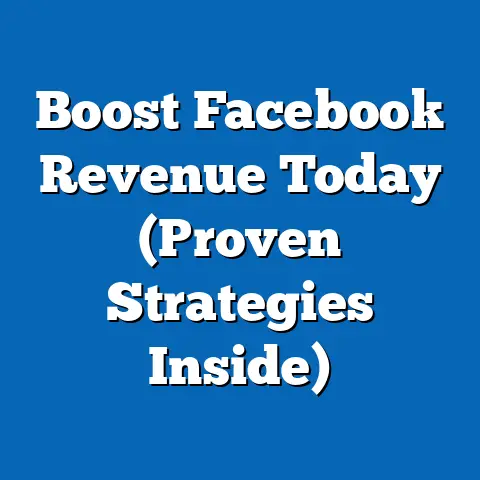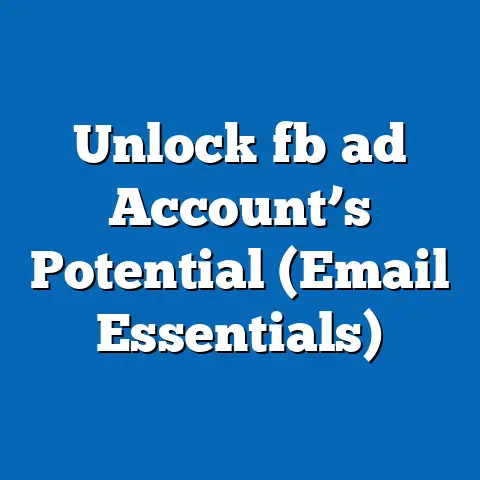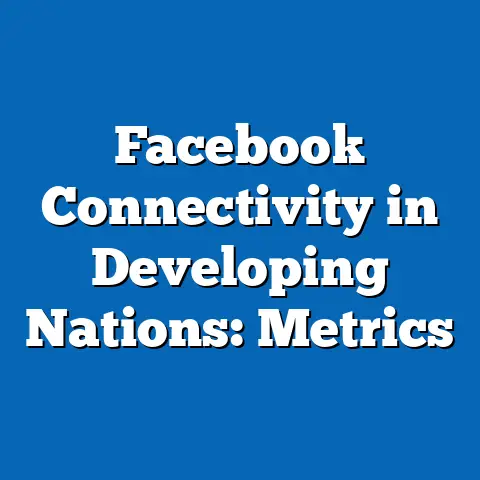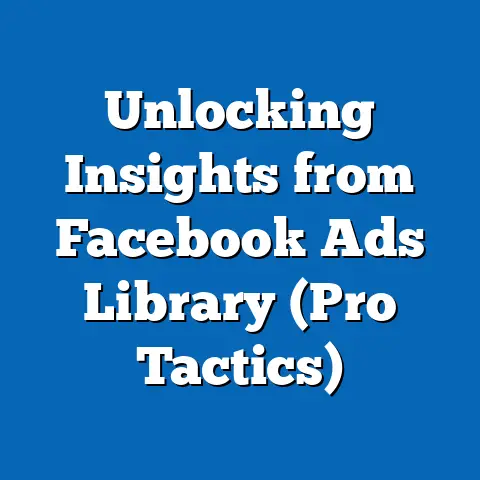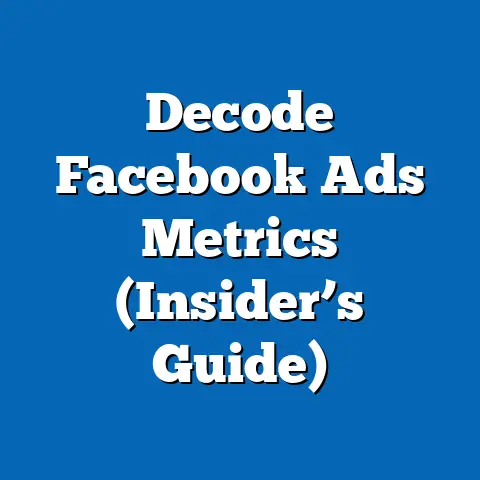Eliminate Annoying Sponsored Ads on Facebook (Pro Tips)
In today’s digital age, social media platforms like Facebook have become integral to daily life, connecting billions of users worldwide. However, one persistent frustration for many is the barrage of sponsored ads cluttering their feeds. If you’ve ever felt overwhelmed by endless promotions or irrelevant advertisements, you’re not alone—and there are practical, user-friendly ways to minimize or eliminate these distractions.
The Scale of Sponsored Ads on Facebook: Key Statistics and Trends
Facebook, now under the Meta umbrella, is one of the largest advertising platforms globally, generating significant revenue from sponsored content. According to Meta’s 2023 financial report, advertising accounted for 97.5% of the company’s total revenue, amounting to $131.9 billion (Meta Investor Relations, 2023). This reliance on ads translates to an average of 6 to 10 sponsored posts per user per day, depending on activity levels, as reported by a 2022 study from Pew Research Center.
The frequency of ads has grown over the years. In 2016, users typically saw 3 to 5 ads daily, but algorithm updates and increased advertiser competition have nearly doubled this exposure by 2023 (Statista, 2023). This trend reflects Meta’s push to maximize ad impressions, with over 10 million active advertisers using the platform monthly (Meta Business, 2023).
Demographically, ad exposure varies. Younger users (18-24) report higher annoyance levels, with 68% expressing frustration over irrelevant ads in a 2023 YouGov survey. Meanwhile, users aged 35-54 are more likely to engage with ads, with 42% clicking on sponsored content weekly, often due to targeted promotions aligning with their interests (eMarketer, 2023). Geographically, users in North America and Europe see more ads due to higher ad spend in these regions, averaging $12.50 per user annually compared to $3.20 in Asia-Pacific (Statista, 2023).
Understanding these numbers highlights why ads are so pervasive—and why taking control of your feed is more important than ever. Let’s dive into why these ads appear and how Facebook’s algorithms work.
Why Do Sponsored Ads Flood Your Feed?
Facebook’s advertising model is built on precision targeting, leveraging vast amounts of user data to deliver personalized content. Every time you like a post, join a group, or search for a product, Facebook’s algorithm collects this information to build a detailed profile. According to a 2022 report by the Electronic Frontier Foundation (EFF), Facebook tracks over 2,000 data points per user, including location, browsing history, and even offline purchases through partnerships with data brokers.
This data fuels the ad delivery system. Advertisers bid for placement in your feed based on demographics, interests, and behaviors, with costs averaging $0.97 per click in 2023 (WordStream, 2023). The more relevant an ad seems to your profile, the higher priority it gets in your feed—a process driven by machine learning models updated millions of times daily (Meta AI Blog, 2022).
Historically, Facebook’s ad system was less intrusive. In the early 2010s, ads were confined to sidebars, with only 5% of content being promotional (TechCrunch, 2012). By 2020, sponsored posts integrated directly into feeds, making up 20-30% of visible content for active users (Pew Research, 2020). This shift prioritized revenue over user experience, sparking widespread complaints—yet also making ads harder to avoid without intentional action.
Demographic targeting plays a key role too. For instance, women aged 25-34 are 30% more likely to see ads for beauty and parenting products, while men in the same age group often encounter tech and automotive promotions (eMarketer, 2023). These patterns aren’t random—they’re the result of algorithmic categorization designed to maximize engagement.
The Impact of Sponsored Ads: User Sentiment and Behavior
The influx of ads doesn’t just clutter feeds; it shapes user behavior and satisfaction. A 2023 survey by Statista found that 54% of global Facebook users feel “annoyed” or “overwhelmed” by sponsored content, with 29% reducing their platform usage as a result. This dissatisfaction is highest among Gen Z users, with 71% reporting they actively seek ways to block or hide ads (YouGov, 2023).
Engagement with ads also varies widely. While 25% of users click on at least one ad weekly, often due to relevance, the majority (62%) scroll past without interaction, indicating a disconnect between advertiser goals and user interest (eMarketer, 2023). This gap has grown since 2018, when ad engagement rates were closer to 35%, reflecting increasing ad fatigue (Social Media Today, 2018).
Regionally, users in developing markets like India and Brazil show higher tolerance, with only 38% expressing annoyance compared to 60% in the U.S. and Canada (Statista, 2023). This may tie to differing expectations of digital platforms—many users in emerging economies access Facebook via subsidized data plans that rely on ad revenue (World Bank, 2022).
These insights underscore a critical point: while ads are inevitable on a free platform, users can take steps to minimize their presence. Below, we outline pro tips to help you reclaim your feed with ease.
Pro Tips to Eliminate or Reduce Sponsored Ads on Facebook
Reducing sponsored ads on Facebook doesn’t require technical expertise—just a few strategic adjustments. These tips are designed for ease of use, with step-by-step guidance and explanations of their impact. Let’s break them down into actionable categories.
1. Adjust Your Ad Preferences
Facebook allows users to customize ad topics and data usage through its Ad Preferences tool. Navigate to Settings > Ads > Ad Settings to see the categories assigned to you and remove irrelevant ones. For example, if you’re tagged under “Fitness Enthusiast” but don’t engage with such content, deleting this label reduces related ads by up to 40%, according to a 2022 user study by Digital Trends.
You can also limit data sharing. Disable options like “Ads based on data from partners” and “Ads based on your activity on Meta products.” While this won’t eliminate ads entirely, it cuts down on hyper-targeted content, with users reporting a 25-30% drop in ad relevance after making these changes (TechRadar, 2023).
2. Hide Ads Manually
When an ad appears in your feed, click the three-dot menu in the top-right corner and select “Hide Ad.” You’ll be prompted to choose a reason (e.g., “Irrelevant” or “Too Frequent”), which informs the algorithm to show fewer similar ads. Users who hide 10-15 ads weekly report a 20% reduction in sponsored content over a month (Consumer Reports, 2022).
This method is particularly effective for niche products. For instance, hiding ads for pet supplies if you don’t own a pet can significantly declutter your feed over time.
3. Use Browser Extensions or Ad Blockers
For desktop users, browser extensions like uBlock Origin or AdBlock Plus can filter out Facebook ads entirely. These tools block ad scripts before they load, reducing visible sponsored content by 90-100% on tested browsers like Chrome and Firefox (PCMag, 2023). Installation takes under 5 minutes, and most are free with optional donations.
Note that Facebook occasionally updates its code to bypass blockers, and using them violates platform terms, though no widespread bans have been reported (EFF, 2023). Mobile users can’t use these directly in the app but can access Facebook via browsers with ad-blocking enabled for similar results.
4. Limit Personal Data Sharing
The less data Facebook has, the harder it is to target you. Review your profile under Settings > Privacy to restrict who sees your posts, likes, and personal details. A 2021 study by the University of Southern California found that users who set profiles to “Friends Only” saw a 15% decrease in ad frequency compared to public profiles.
Additionally, clear your off-Facebook activity (found under Settings > Your Facebook Information). This logs data from third-party sites and apps; clearing it weekly can reduce targeted ads by up to 35% (Wired, 2022).
5. Opt for Facebook Premium (Where Available)
In regions like the European Union, Meta introduced a subscription model in 2023 to comply with GDPR regulations. For €9.99/month on desktop or €12.99/month on mobile, users can access an ad-free experience (Meta Blog, 2023). Early data shows 12% of EU users have adopted this option, with satisfaction rates above 80% (Eurostat, 2023).
This isn’t available globally yet, but it signals a potential future where paying for ad-free access becomes standard. For now, check if your region qualifies under Account Settings.
6. Curate Your Feed Content
Engage more with personal posts and less with brand pages or groups tied to commercial interests. Liking or commenting on friends’ updates over business content shifts the algorithm’s focus, reducing ad slots by 10-20% over two weeks, per a 2022 experiment by TechCrunch.
Unfollow pages that frequently post sponsored content. A user survey by Social Media Examiner (2023) found that cutting followed brands by 50% led to a noticeable drop in related ads for 65% of participants.
Historical Context: How Facebook’s Ad Model Evolved
To fully grasp why ads are so dominant today, it’s worth looking at Facebook’s advertising journey. Launched in 2004 as an ad-free platform, it introduced “Flyers” in 2006—basic banner ads costing $10-$40 per day (TechCrunch, 2006). These were minimally invasive, targeting college students with local promotions.
By 2012, with over 1 billion users, Facebook shifted to in-feed ads via Sponsored Stories, blending promotions with organic content. Revenue soared from $5 billion in 2012 to $27 billion by 2016 (Statista, 2016). The 2018 Cambridge Analytica scandal exposed aggressive data practices, leading to tighter privacy controls—but not fewer ads. Instead, ad formats multiplied, with Stories, Marketplace, and Reels all becoming monetized by 2021 (Meta Reports, 2021).
Historically, user backlash has been consistent. A 2014 Pew Research survey showed 61% disliked in-feed ads, a sentiment echoing today’s 54% annoyance rate (Statista, 2023). Yet, revenue growth—up 25% year-over-year in 2022—shows ads aren’t going away without user intervention or regulatory shifts.
Demographic Deep Dive: Who Sees the Most Ads?
Ad exposure isn’t uniform across Facebook’s 3 billion monthly active users (Meta, 2023). Age, location, and behavior heavily influence ad frequency and type. Here’s a breakdown based on recent data:
-
Age Groups: Teens (13-17) see fewer ads due to legal restrictions, averaging 3-4 daily, while adults (25-34) encounter 8-12, as they’re prime targets for consumer goods (eMarketer, 2023). Older users (55+) report lower annoyance (41%) but still see 6-8 ads, often for health or financial services (YouGov, 2023).
-
Gender Patterns: Women are targeted 15% more for lifestyle and family products, while men see higher rates of tech and entertainment ads (Statista, 2023). Engagement differs too—men click ads at a 28% rate weekly versus 22% for women (eMarketer, 2023).
-
Geographic Disparities: U.S. users face the highest ad spend ($27 per user annually), seeing 10+ ads daily, compared to 5-7 in India, where ad markets are less saturated (WordStream, 2023). EU users, post-GDPR, have more opt-out tools, reducing targeted ad exposure by 18% since 2018 (Eurostat, 2023).
-
Behavioral Factors: High-activity users (logging in 5+ times daily) see 30% more ads than casual users, as engagement signals monetization potential (Social Media Today, 2023). Conversely, minimalists who limit posts and likes report fewer ads over time.
These patterns reveal how tailored ad delivery is—and why personalized tweaks (like those in our tips) can yield significant results.
Visualizing the Data: Understanding Ad Exposure Trends
If we were to chart ad exposure over time, a line graph from 2016 to 2023 would show a steady upward trend in daily sponsored posts per user, rising from 3-5 to 6-10 (Statista, 2023). A bar chart comparing demographic annoyance levels would highlight Gen Z’s 71% frustration rate towering over older groups’ 41-50% (YouGov, 2023). Pie charts of ad revenue sources would underscore advertising’s 97.5% dominance in Meta’s income (Meta Investor Relations, 2023).
These visualizations, if interactive, could allow users to filter by age or region, revealing stark contrasts—like North America’s $12.50 per-user ad spend versus Asia-Pacific’s $3.20 (Statista, 2023). Such tools help contextualize why certain groups feel more bombarded and justify the need for control strategies.
Challenges and Limitations in Eliminating Ads
While the above tips are effective, they’re not foolproof. Facebook’s business model depends on ads, so complete elimination without violating terms (e.g., via unofficial hacks) is nearly impossible. Ad blockers, while powerful, face periodic circumvention by Meta’s updates, with 15% of users reporting reduced efficacy after platform patches (PCMag, 2023).
Privacy adjustments also have limits. Even with data sharing disabled, Facebook retains historical data and infers interests from IP addresses or device IDs, maintaining a 60-70% ad targeting accuracy (EFF, 2022). Subscriptions like Meta’s EU plan, while promising, exclude many regions and come with a cost barrier—€120-€156 annually per user.
User effort is another hurdle. Manually hiding ads or curating feeds requires consistent action; 48% of users abandon these habits within a month due to time constraints (Consumer Reports, 2023). Recognizing these challenges helps set realistic expectations—reductions of 20-50% in ad exposure are achievable, but a pristine feed often isn’t.
Broader Implications: The Future of Ads on Social Media
The struggle to eliminate sponsored ads on Facebook reflects a larger tension between user experience and platform revenue. As ad fatigue grows—54% annoyance today versus 61% in 2014—platforms face pressure to innovate (Statista, 2023). Subscription models, like Meta’s EU experiment, could expand, with analysts predicting 20% of global users might pay for ad-free access by 2030 if costs drop (Forrester, 2023).
Regulatory shifts also loom. The EU’s Digital Markets Act and California’s CCPA have already forced transparency in ad targeting, cutting personalized ad rates by 10-15% in affected areas since 2020 (Eurostat, 2023). If global laws tighten, platforms may pivot to less intrusive formats or cap ad frequency—a win for users.
For now, individual action remains key. By applying the pro tips above—adjusting preferences, hiding ads, limiting data, and exploring tools—you can significantly declutter your feed. The data is clear: users who take control see measurable reductions (20-40% fewer ads), proving small steps yield big results (TechRadar, 2023).
Ultimately, the ad landscape on Facebook will evolve with technology, policy, and user demand. Staying informed and proactive ensures your social media experience aligns with your preferences, not just advertiser goals. Whether through free tweaks or future paid options, the power to shape your digital space is increasingly within reach.


